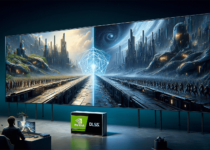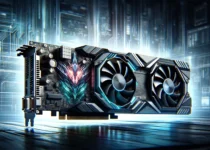Which Graphic card is best for Laptop: Let’s Compare
In the digital era, where technology is evolving at a lightning-fast pace, making sense of the complex labyrinth of graphic cards can be an overwhelming task. Whether you’re a gamer seeking to conquer virtual realms or a professional needing high-quality graphics for your work applications, your laptop’s performance significantly depends on its graphic card. This article titled Which Graphic Card is Best for Laptop aims to demystify this vital component and serve as your compass in navigating towards the ideal choice.
In this constantly shifting tech landscape, it’s crucial to make informed decisions that would optimize not just functionality but also affordability and longevity. If you’re pressed for time and looking for a quick answer, Nvidia’s GeForce RTX 30 series currently reigns supreme in the realm of laptop graphics cards. However, read on if you wish to delve deeper into understanding what makes one graphic card outshine others.
Importance of Graphics Cards in Laptops
Directly diving into the importance of graphics cards, they are not just for gamers or digital artists. They’re an integral component that significantly impacts the total computing capability of your laptop. For instance, any tasks involving video content – be it streaming your favorite movie, attending a Zoom meeting, or rendering video files, heavily depend on your GPU (Graphics Processing Unit). In other words, it makes these everyday experiences smoother and more efficient.
In today’s era, where Artificial Intelligence and Machine Learning are trending technologies, Graphics Cards have gained prominence as they accelerate these operations by performing multiple calculations simultaneously. This reduces computational time radically while maximizing the speed and efficiency of your laptop. Hence, from watching HD movies to creating complex 3D design models or even executing Big Data Algorithms with ease and precision—the optimized power of graphics cards is realizing new possibilities in our digital lives!
Top High-end Graphic Cards for Laptops
A modern-day depiction of technological advancement and computing power is most visibly seen in the realm of laptop graphics cards. As these microcosms of pixel-pushing power continue to evolve, they are breaking barriers for gaming, content creation, and advanced VR applications on laptops. Let’s talk about some top-notch, high-end graphic cards that can radically enhance your laptop’s visual performance.
Firstly, the NVIDIA GeForce RTX 2080 Super is a titan in this arena. It embodies perfection for gamers with its RTX real-time ray tracing technology and AI-enhanced graphics. On the other hand, if you’re a professional artist or content creator, then NVIDIA Quadro RTX 5000 should be your pick; it flaunts powerful Tensor cores useful for machine learning applications and high-quality photo-realistic rendering.
On AMD’s table lies the Radeon Pro WX 7100, which promises workstation-class performance with an incredible bandwidth speed for large data sets and complex designs. Indeed, these GPUs showcase not only astounding performance but also illustrate a glimpse of what the future holds in GPU technologies!
Best Mid-range Graphic Cards for Laptop Users
Diving into the dynamic realm of mid-range graphics cards, ideal for optimizing your laptop performance without burning a hole in your pocket, reveals two game-changers: NVIDIA GeForce GTX 1650 and AMD Radeon RX 560X. These are not just about affordability but also pack an impressive punch when it comes to boosting gaming experiences and handling demanding design software.
The NVIDIA GeForce GTX 1650 is a powerful ally that expels any lag with its groundbreaking Turing architecture capable of enhancing all modern games on medium settings. On the other side, crowning its position within this fiercely competitive arena is AMD’s Radeon RX 560X – a force to be reckoned with in terms of multitasking efficiency, taking on graphics-intensive software like Autodesk or Adobe Suite with unparalleled ease. Both GPUs display relentless dedication to impressively high-speed functionality and exceptional screen quality across various applications, making them ultimate weapons for laptop users seeking superior performance at reasonable rates.
Affordable Budget-Friendly Graphic Cards Options for Laptops
If you’re seeking high-quality graphic performance on a budget, look no further than the GeForce GT 730 Zone Edition. Despite being easy on your wallet, this graphics card packs a punch when it comes to optimizing gaming and multimedia experiences on your laptop. Known for its silent operation due to an absence of fans, this GPU ensures you can enjoy long hours of gameplay or video editing without worrying about noise or overheating.
On another note, the Geforce 210 is a game-changer for those searching for a top-notch affordable graphics card solution. This low-profile option fits snuggly into your laptop without compromising room or computing power. With its superior HD rendering ability and DirectX 10 support, the Geforce 210 enhances your digital media like never before while providing sterling support for Windows Operating System versions going back to Windows XP!
Factors to Consider When Choosing a Graphic Card for a Laptop
Diving right into the realm of Graphics Processing Units (GPUs), your laptop’s performance is highly susceptible to the chosen graphic card. One critical factor you must contemplate is the ‘RAM’ – yes, ‘Video RAM.’ While your machine might be boasting of 8GB or 16GB RAM, your graphic card also needs separate memory while performing tasks. A higher Video RAM (at least 4GB) ensures smoother functioning of games and video editing software. However, remember that too much VRAM isn’t necessary unless you’re going into heavy applications.
An often-overlooked factor when choosing a GPU is bandwidth – essentially, how quickly it can read data from memory. Despite having loads of VRAM, if your graphics card’s memory bandwidth is low, it will take longer for data to get where it needs to go, resulting in dropped frames or janky gameplay in high-demand scenarios.
Try looking for cards with a minimum bandwidth of around 192 GB/s for optimal performance. Lastly but importantly, aimed at future-proofing your investment, consider opting for laptops equipped with USB-C ports, which are compatible with external GPUs and facilitate portability while delivering demanding graphical power!
Final Thoughts
In conclusion, the best graphics card for a laptop greatly depends on individual needs and preferences. For those seeking top-notch performance and gaming experience, Nvidia GeForce RTX 3080 is undeniably the best choice. However, for budget-conscious users who still want decent performance, AMD Radeon Pro 560 might be the right fit. It’s important to research and compare specifications, taking into consideration your specific needs and the laptop’s compatibility. No matter which graphic card you choose, ensure it caters to your requirements from your laptop usage to maximize its potential.
FAQs
Can I run high-end games without a dedicated graphics card on my laptop?
High-end games usually require a dedicated graphics card to run smoothly and at higher settings.
Does having a better graphics card also improve the battery life on my laptop?
Not necessarily; more powerful graphic cards can often result in shorter battery life due to their higher power consumption.


